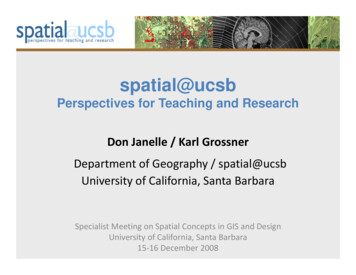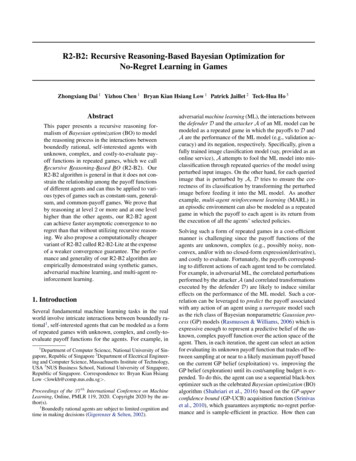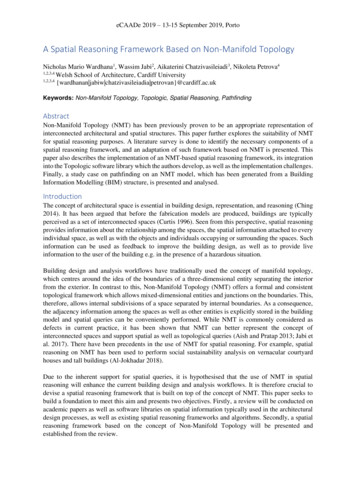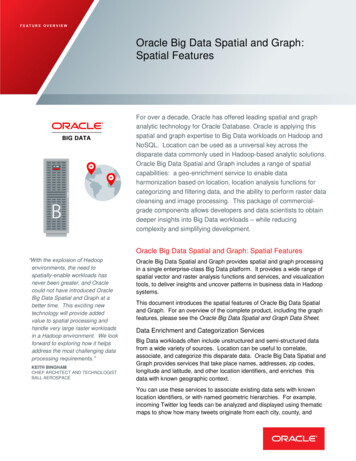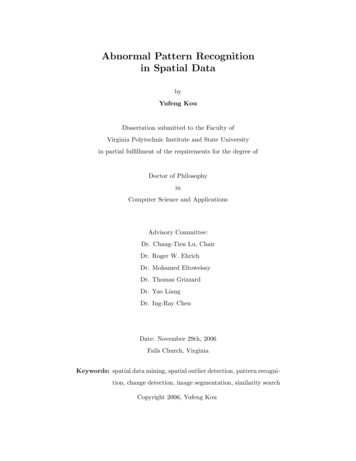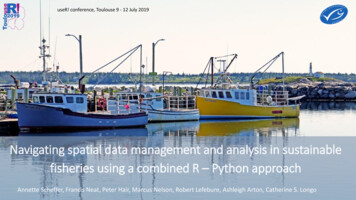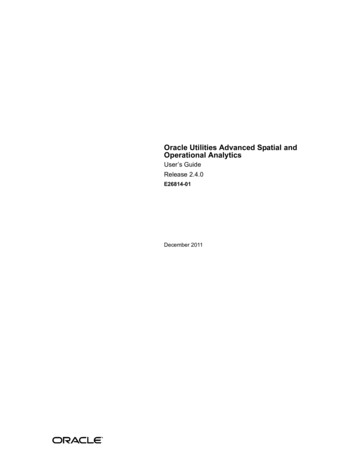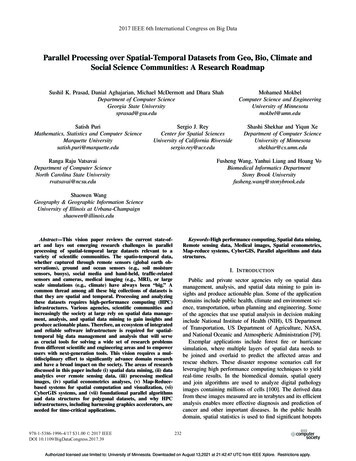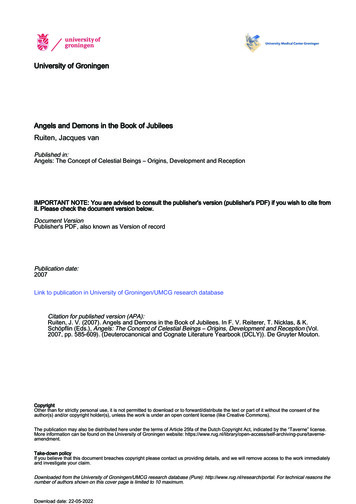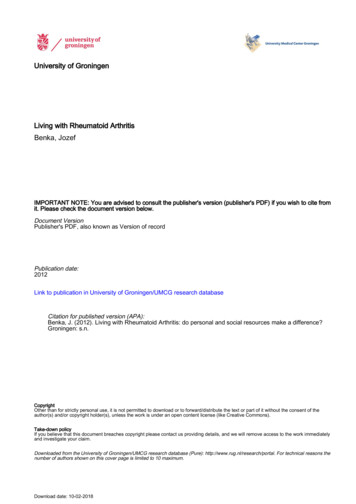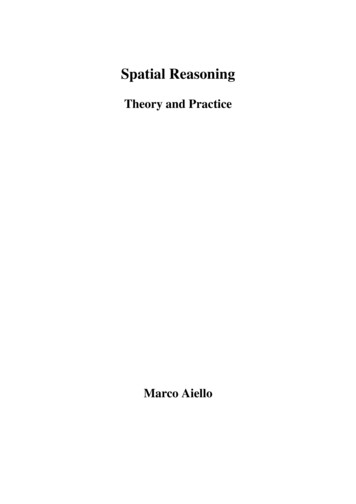
Transcription
Spatial ReasoningTheory and PracticeMarco Aiello
Spatial ReasoningTheory and Practice
ILLC Dissertation Series 2002-2For further information about ILLC-publications, please contactInstitute for Logic, Language and ComputationUniversiteit van AmsterdamPlantage Muidergracht 241018 TV Amsterdamphone: 31-20-525 6051fax: 31-20-525 5206e-mail: illc@science.uva.nlhomepage: http://www.illc.uva.nl/
Spatial ReasoningTheory and PracticeACADEMISCH P ROEFSCHRIFTter verkrijging van de graad van doctor aan deUniversiteit van Amsterdamop gezag van de Rector Magnificusprof.mr. P.F. van der Heijdenten overstaan van een door het college voor promoties ingesteldecommissie, in het openbaar te verdedigen in deAula der Universiteitop vrijdag 22 februari 2002, te 12.00 uurdoorMarco Aiellogeboren te Fabriano, Italië.
Promotie commissie:Promotores:prof.dr J.F.A.K. van Benthemprof.dr ir A.M.W. SmeuldersOverige leden:prof.dr L. Fariñas del Cerro, Université Paul Sabatier, Frankrijkprof.dr ir F. Giunchiglia, Università di Trento, Italiëprof.dr ir R. Scha, Universiteit van Amsterdam, Nederlanddr M. de Rijke, Universiteit van Amsterdam, Nederlanddr Y. Venema, Universiteit van Amsterdam, NederlandFaculteit der Natuurwetenschappen, Wiskunde en InformaticaUniversiteit van AmsterdamNederlandThe research was supported by the Institute for Logic, Language and Computation andby the Informatics Institute of the University of Amsterdam.Copyright c 2002 by Marco Aiellohttp://www.aiellom.itCover design and photography by the author.Typeset in pdfLATEX.Printed and bound by Print Partners Ipskamp, Enschede.ISBN: 90–5776–079–7
A Mario e Gigina.v
C ONTENTSAcknowledgmentsxi1Introduction1.1 Reasoning about space . . . . . . . . . . . . . . . . . . . . . . . . .1.2 Theory and practice . . . . . . . . . . . . . . . . . . . . . . . . . . .1132The topo approach: expressiveness2.1 Basic modal logic of space . . . . . .2.1.1 Topological bisimulation . . .2.1.2 Connections with topology . .2.1.3 Topo-bisimilar reductions . .2.2 Games that compare visual scenes . .2.2.1 Strategies and modal formulas2.3 Logical variations . . . . . . . . . . .3.The topo approach: axiomatics3.1 Topological spaces and Kripke models . .3.1.1 The basic connection . . . . . . .3.1.2 Analogies . . . . . . . . . . . . .3.2 General completeness . . . . . . . . . . .3.2.1 The main argument . . . . . . . .3.2.2 Topological comments . . . . . .3.2.3 Finite spaces suffice . . . . . . .3.3 Completeness on the reals . . . . . . . .3.3.1 Cantorization . . . . . . . . . . .3.3.2 Counterexamples on the reals . .3.3.3 Logical non-finiteness on the reals3.4 Axiomatizing special kinds of regions . .3.4.1 Serial sets on the real line . . . .vii.78111314141820.2323232525262829313235394242
3.53.4.2 Formulas in one variable over the serial sets . .3.4.3 Countable unions of convex sets on the real line3.4.4 Generalization to IR2 . . . . . . . . . . . . . .A general picture . . . . . . . . . . . . . . . . . . . .3.5.1 The deductive landscape . . . . . . . . . . . .4 Logical extensions4.1 Universal reference . . .4.2 Alternative extensions . .4.2.1 Hybrid reference4.2.2 Until a boundary4.3 Standard logical analysis.5 Geometrical extensions5.1 Affine Geometry . . . . . . . . . . . . . . . . . .5.1.1 Basic geometry . . . . . . . . . . . . . . .5.1.2 The general logic of betweenness . . . . .5.1.3 Modal languages of betweenness . . . . . .5.1.4 Modal logics of betweenness . . . . . . . .5.1.5 Special logics . . . . . . . . . . . . . . . .5.1.6 Logics of convexity . . . . . . . . . . . . .5.1.7 First-order affine geometry . . . . . . . . .5.2 Metric geometry . . . . . . . . . . . . . . . . . . .5.2.1 The geometry of relative nearness . . . . .5.2.2 Modal logic of nearness . . . . . . . . . .5.2.3 First-order theory of nearness . . . . . . .5.3 Linear algebra . . . . . . . . . . . . . . . . . . . .5.3.1 Mathematical morphology and linear logic5.3.2 Richer languages . . . . . . . . . . . . . .6 A game-based similarity for image retrieval6.1 Introduction . . . . . . . . . . . . . . . . . .6.2 A general framework for mereotopology . . .6.2.1 Expressiveness . . . . . . . . . . . .6.2.2 Comparison with RCC . . . . . . . .6.3 Comparing spatial patterns . . . . . . . . . .6.3.1 Model comparison games distance . .6.4 Computing similarities . . . . . . . . . . . .6.4.1 Methodology . . . . . . . . . . . . .6.4.2 Polygons of the plane . . . . . . . . .6.4.3 The topo-distance algorithm . . . . .6.5 The IRIS prototype . . . . . . . . . . . . .6.5.1 Implementing the similarity measure 19
6.678Discussion . . . . . . . . . . . . . . . . . . . . . . . . . . . . . . . . 122Thick 2D relations for document understanding7.1 Introduction . . . . . . . . . . . . . . . . . .7.2 A logical structure detection architecture . . .7.3 Methodology . . . . . . . . . . . . . . . . .7.3.1 Document encoding rules . . . . . .7.3.2 Relations adequate for documents . .7.3.3 Inference . . . . . . . . . . . . . . .7.4 Evaluation . . . . . . . . . . . . . . . . . . .7.4.1 Criteria . . . . . . . . . . . . . . . .7.4.2 Results . . . . . . . . . . . . . . . .7.4.3 Discussion of the results . . . . . . .7.5 Concluding remarks . . . . . . . . . . . . . 18.1 Where we stand . . . . . . . . . . . . . . . . . . . . . . . . . . . . . 1518.2 Final remarks on theory and practice . . . . . . . . . . . . . . . . . . 152A A bit of topology155B Sorting transitive directed graphs159C Implementations163C.1 Topax . . . . . . . . . . . . . . . . . . . . . . . . . . . . . . . . . . 163C.2 IRIS . . . . . . . . . . . . . . . . . . . . . . . . . . . . . . . . . . . 169C.3 SpaRe . . . . . . . . . . . . . . . . . . . . . . . . . . . . . . . . . . 171Bibliography181Index193Samenvatting199ix
ACKNOWLEDGMENTSI believe that a PhD thesis is not the effort of an individual, but the final outcome ofa synergy. Since there is officially one author, I feel the urge to thank in these initialpages the people involved in a way or another with my PhD project.I arrived in Amsterdam four years ago as a lost soul. Unlike Voltaire’s Candide, Ifound generosity, humor, inspiration and, most importantly, solid scientific values tobelieve in. I realized my conversion to the ‘Amsterdam school’ was complete when Ireceived an email in which I was addressed as a “modal logician.” What a joy. I didnot even know what a ‘modal logic’ was till I moved my first steps in Amsterdam. Iftoday someone may recognize me as a credible scientist, I own it first and foremost toJohan van Benthem.One of the many qualities of Johan I had the privilege to appreciate, and I am sureI share this feeling with many others, is his natural disposition of putting everyoneat ease. I could always raise a question, no matter how silly, and get a simple yetilluminating answer. Every occasion to meet, discuss or even exchange emails withJohan have been pleasurable events which I have and I will be looking forward to. Inshort, Johan thank you.I am deeply in debt with Arnold Smeulders for his continuous interest in my work,for his warm supervision, and for an extreme availability. He provided me with visionary questions, while leaving me a considerable amount of freedom in my research. Ionly wish I could have answered more of his questions. Not to please him, but becauseif I did, I would be a famous scientist today.I am thankful to a number of researchers of the University of Amsterdam and CWI.I could always knock on their doors and find an interested and competent mind at mydisposal, in particular, Rein van den Boomgaard, Kees Doets, Henk Heijmans, Dick deJong, Michiell van Lambalgen, Maarten Marx, Maarten de Rijke, and Yde Venema.Special thanks go to Krzysztof Apt. Interacting with him has taught me a lot aboutscience and, also, on academic life’s pleasures and pitfalls. I have appreciated his trustwhen he proposed to me to become the information director of the new ACM journalhe was founding, the Transactions on Computational Logic (TOCL). Our occasionalxi
Tuesdays lunches were both filled with precious information and humor. I should haveknown he was a funny guy from the very beginning, after all on his homepage you canread “Recent Publications (Important notice: I have read them all.)”I also thank my co-authors. I have learned a great deal in many dimensions fromworking with all of them: Johan van Benthem, Arnold Smeulders, Guram Bezhanishvili, Maarten de Rijke, Christof Monz, Carlos Areces, the ‘trentini’ Luciano Serafini, Paolo Busetta, Antonia Donà, Alessandro Agostini, and the document analysisfolks Marcel Worring, and Leon Todoran.Discussing scientific issues at conferences, during lab visits or even via email, hada huge impact on my ideas for the thesis. I can not cite everybody in such a societyof minds. Let me just thank them all, and recall a few: Brandon Bennett, GuramBezhanishvili, Luis Fariñas del Cerro, Alessandro Cimatti, Anthony Cohn, AlbertoFinzi, Dov Gabbay, Valentin Goranko, Oliver Lemon, Carsten Lutz, Donato Malerba,Angelo Montanari, Carla Piazza, Alberto Policriti, Ian Pratt, Dave Randell, OlivieroStock, Paolo Traverso, Achille Varzi, and Laure Vieu.Fiora Pirri, Fausto Giunchiglia, Mike Papazoglou, and Henk Heijmans invited meto visit their labs and present my work. The lab visits have been great experiencesfostering discussion and collaboration. I spent two months at IRST, Trento as a followup to one of such invitations. I would like to thank Fausto for making this possible,and all the people at IRST for providing a productive and fun environment.I would like to thank the participants in the workshop on modal logics of spaceorganized by Yde Venema and myself in Amsterdam on May the 10th 1999, and especially the invited speakers: Philippe Balbiani, Luis Fariñas del Cerro, Volker Haarslev,Oliver Lemon, Ian Pratt, and Vera Stebletsova, for contributing to the success of theevent. The spatial reasoning reading group at ILLC, which began its meetings shortlyafter the workshop, with its regular members Rosella Gennari, Gwen Kerdiles, VeraStebletsova, and Yde Venema, provided a great learning opportunity. In particular,Yde’s explanations have been fundamental in my understanding of spatial logics.At the crossing between scientific collaboration and friendship I thank all the colleagues of ILLC and ISIS, in particular: Carlos Areces, Raffaella Bernardi, RosellaGennari, Eva Hoogland, Gwen Kerdiles, Nikos Massios, Christof Monz, Marc Pauly,Leon Todoran, and Renata Wassermann. Carlos, Christof, and Rosella also volunteered to proofread the thesis. I thank them both for their precious remarks and theirmasochism. Peter Block, Ingrid van Loon, and Marjan Veldhuisen of the administrative staff at ILLC were there for me whenever needed. Thank to them, I never had toworry about anything different from my PhD.Amsterdam is a fun city to live in. But it is even better with the right friends. Iam grateful to the Dutch friends for introducing me to the Netherlands, and to the nonDutch friends for exploring things with me: Arantxa, Christiaan en Mirjam, Christof,Elena, Jelle, Jilles, Karen, Paola, Piero, Tom en Annemieke, the basketball teammatesof the USC and Schrobbelaar.During my visits to Stanford, I had the opportunity to enjoy the warm hospitalityof Richard and Fran Waldinger, for which I am very thankful.xii
A number of friends from Italy came to visit me in Amsterdam, giving relief (aswell as Parmigiano cheese) to an emigrant’s life. I thank them all for the time spenttogether in the ‘low-lands’: Simone e Margherita (also thank you for making me feelless lonely on my regular trips to Sassari), Ada, Alberto, Alessandra, Alessandro eClaudia, Cinzia, Franco e Federica, Claudio e Barbara, Daniele, Fabio, Irma, Massimoe Nadia, Mattia e Alessandra, Nicola, Paola, and Paolo e Giulia. In particular, I thankIrma Rosati and Mattia De Rosa for kindly accepting to be my paranimphs during thepublic defense of this thesis.Finally, I acknowledge the Italian National Research Council (CNR) for providingextra financial support (part of which I converted in an indispensable companion—woz—an Apple Powerbook G3). In addition, I acknowledge the following fine organizations for providing support through their travel awards: the Italian Association forArtificial Intelligence (AI*IA), the Center for the Study of Language and Informationat Stanford (CSLI), and the Organization Committee of the 7th European Workshop onLogics in Artificial Intelligence (Jelia 2000).The thesis, which would not be there without the love of Claudia, is dedicated tomy parents and grandparents. In particular, I dedicated it in memoriam to Mario Aiello,the father, but also the computer scientist, on the 25th anniversary of his death.Amsterdam, October 29th 2001Marco Aielloxiii
C HAPTER 1I NTRODUCTION1.1Reasoning about spaceSpatial structures and spatial reasoning are essential to perception and cognition. Muchday-to-day practical information is about what happens at certain spatial locations.Moreover, spatial representation is a powerful source of geometric intuitions that underlie general cognitive tasks. How can we represent spatially located entities andreason about them? To take a concrete domestic example: when we are setting a tableand place a spoon, what are the basic spatial properties of this new item in relation toothers, and to the rest of the space? Not only, there are further basic aspects to perception: we have the ability to compare different visual scenes, and recognize objectsacross them, given enough ‘similarity’. More concretely: which table settings are ‘thesame’? This is another task for which logic provides tools.Constraining space within the bounds of a logical theory and using related formalreasoning tools must be performed with particular care. One cannot expect the movefrom space to formal theories of space to be complete. Natural spatial phenomena willbe left out of logical theories of space, while non-natural spatial phenomena could tryto sneak in (cf. the account of Helly’s theorem implications on diagrammatic theoriesin [Lemon, 2002]). Paraphrasing Ansel Adams’ concern of space bound in a photograph,1 one could say that space in nature is one thing; space confined and restrictedin the bounds of a formal representation and reasoning system is quite another thing.Connectivity, parthood, and coherence, should be correctly handled and expressed bythe formalism, not aiming at a complete representation of space, but focusing on expressing the most perspicuous spatial phenomena.The preliminary and fundamental step in devising a spatial reasoning frameworklays, thus, in the identification of which spatial behaviors the theory should capture and,1“Space in nature is one thing; space confined and restricted by the picture edges is quite anotherthing. Space, scale, and form must be made eloquent, not in imitation of painting arrangements, but interms of the living camera image.” [Adams, 1981]1
2 Chapter 1. I NTRODUCTIONpossibly, in the identification of which practical uses will be made of the framework.A key factor is in appropriately balancing expressive power, completeness with respectto a specific class of spatial phenomena, and computational complexity.The blend of expressivity and tractability we are aiming at points us in the direction of modal logics as a privileged candidate for the formalization task. We willnot go into details on modal logics or on the reason for which modal logics balancenicely expressive power and computational complexity (one can refer to a number oftexts on the subject, including the recent [Blackburn et al., 2001] or the more specific[Vardi, 1997]). To enjoy the theoretical part of the thesis, we assume the reader hassome basic knowledge of modal logic and its best-known possible world semantics(also referred to as Kripke semantics). Strangely enough, even though knowledge ofKripke semantics is helpful for better understanding the presented material, we aregoing to make little use of it, and rather resort to topological semantics, introducedabout 30 years earlier than Kripke semantics by [Tarski, 1938]. Modern modal logicsof space need old modal logic semantics.The attention on spatial reasoning stems, in the case of the present thesis, fromthe interest in applications in the domains of image processing and computer vision,hence, the sub-title Theory and Practice. But this is only one of the many motivationsfor which spatial logics have been considered in the past. These range from the earlyphilosophical efforts [Whitehead, 1929, Lesniewski, 1983] to recent work motivatedby such diverse concerns as spatial representation and vision in AI [Shanahan, 1995,Randell et al., 2001], semantics of spatial prepositions in linguistics [Herskovits, 1997,Winter and Zwarts, 1997], perceptual languages [Dastani et al., 1997, Dastani, 1998],or diagrammatic reasoning [Hammer, 1995, Gurr, 1998, Kerdiles, 2001]. The resulting logics are diverse, too. Theories differ in their primitive objects: points, lines,polygons, regions (contrast [Tarski, 1938] against [Tarski, 1959]). Likewise, theories differ in their primitive spatial relations: such as inclusion, overlap, touching,‘space’ versus ‘place’, and on how these should be interpreted: [Randell et al., 1992,Bennett, 1995, Asher and Vieu, 1995]. There are mereological theories of parts andwholes, topological ones (stressing limit points, and connection) and mereotopologicalones (based on parthood and external connection). Systematic accounts of the genesisof spatial vocabulary date back to Helmholtz’ work on invariants of movement, butno generally agreed primitive relations have emerged on the logic side. Moreover, axioms differ across theories: [Clarke, 1981, Clarke, 1985] vs [Pratt and Schoop, 1998]vs [Casati and Varzi, 1999]. Also our modal approach has its predecessors of which wemention [Segerberg, 1970, Segerberg, 1976, Shehtman, 1983, Bennett, 1995, Venema,1992, Balbiani et al., 1997, Lemon and Pratt, 1998].The above references have no pretense of being a complete overview of the literature on spatial formalisms and, even less, on applications of spatial formalisms. Weshall refer, discuss and compare our work with the literature, with previous approachesand systems on a ‘local basis’. That is, relevant literature is discussed in each chapter where appropriate in order to set the context, compare our approach with previousones, and identify future extensions of our own work based on previous efforts.
1.2. Theory and practice 31.2Theory and practiceOur contribution with this thesis is twofold. On the one hand, we investigate newand existing spatial formalisms with the explicit goal of identifying languages nicelybalancing expressive power and tractability. On the other hand, we study the feasibilityof practical applications of such qualitative languages of space, by investigating twosymbolic approaches to pattern recognition.The structure of the thesis reflects the two sub-tasks. The first part reflects theethereal nature of our theoretical approach to space. The second part reflects a morepractical task , that is, applying spatial theories to real world problems.Modal formalisms are the thread of the thesis. We walk through a family of modallanguages of space for topological, affine, metric and vector spaces. The task is notthat of compiling a drudging taxonomy of modal spatial languages, but rather to designlanguages with specific expressive tasks. ‘Expressivity in balance’ is the motto here.While walking through modal logics of space some steps will be mandatory. Somebasic languages are needed as they form the basic for any subsequent analysis. This isthe case of S4: a poor language in terms of expressivity, but, as it turns out, the minimal normal modal language with respect to topological interpretations. In fact, thislanguage will be our first test. On this language we shall introduce the topological semantics (after Tarski), define adequate notions of bisimulations and model comparisongames, analyze completeness in modern terms (via canonical models), and more.Our subsequent investigation concerns some striking facts about S4. First, we consider completeness with respect to general topological spaces, to Cantor space, to thereal line, and further to serial sets of the real line and plane. Spatial finiteness arisesas a result. Then, we look at logical extensions. A typical example of this kind of language is that of S4u , an extension by a universal modal operator. S4u is known in theliterature of spatial reasoning as Bennett [1995] used it to encode a decidable fragmentof the region connection calculus of Randell, Cui and Cohn [1992]. Further examplescomprise the spatial extension of the temporal Since and Until logic of [Kamp, 1968].Our next move is from topology to geometric structures. This involves a majorsemantic change. Topological interpretation is abandoned, and more custom possibleworlds semantics is used. In this context, modal logics tend to either be sorted (typicalexample is that of having sorts for points and lines, and an incidence relation) or toadopt dyadic modal operators. Our focus will be on logics of the second kind.In [Tarski, 1959], Tarski introduces the notion of elementary geometry and provides a first order axiomatization in terms of two fundamental relations, that is, betweenness and equidistance. These are sufficient for any affine or metric construction.For instance, one can define parallelism, convexity, or the notion of an equilateral triangle. But what happens if one considers betweenness in isolation? Further, what isthe modal fragment of languages of betweenness? And, are there alternative relationsfor axiomatizing elementary geometry?We answer these questions in our investigation of geometrical extensions to ourbasic modal approach to space. At the end of our journey in this realm of modal logics,
4 Chapter 1. I NTRODUCTIONwe arrive at a vector theory of shape: mathematical morphology. This mathematicaltheory of shape lends itself naturally to modal representations, as its two basic operators, which mimic Minkowski’s operations in vector spaces, are easily axiomatizedin terms of modal ‘arrow logics’. It will be harder to maintain the balance betweenexpressivity and tractability as small deviations from the minimal axiomatization forcetrespassing the limits of decidability. As a compensation, interesting new axiomatizations and open questions arise. All in all, we shall discover a number of intriguing factsabout topological and geometric spaces, thanks to a modal analysis of space.When considering applications, the point of view on the logics of space analyzed inour theoretical promenade shifts. Now interesting logics become those which can express region properties, rather than those merely referring to points, model comparisongames become interesting only if turned into distance measures, and boundaries ofregions play an even greater role.There are even more general concerns when applying symbolic approaches to pattern recognition problems: spatial coherence and brittleness. Spatial coherence regardsthe way nature presents itself to observation, that is in a manner intrinsically hard tocapture symbolically. Elsewhere we have spelled out our personal concerns for spatialcoherency in the context of formal perceptual languages [Aiello and Smeulders, 1999].We refer to [Florack, 1997] for an authoritative point of view.Brittleness regards a risk ran by strict symbolic approaches when applied to realworld domains: they might break. There are various reasons for which a system canshow a brittle behavior. Little variations present in nature may result in misclassifications at the symbolic level. Thus, the misclassification propagates on to a wronganalysis. The problem occurred in one of the practical systems we present, forcing theintroduction of a ‘less brittle’ interpretation of region relations.We choose two significant problems in image processing and pattern matching asour testing grounds: image retrieval and document image analysis.Image retrieval is achieved by matching a description or a query image on a collection of images. Symbolic approaches are successful in this field to the extent thatsymbolic segmentation of the images is available. The matching process between aquery and a collection of images is a matter of comparison. When analyzing modallogics of space we encounter a tool performing precisely this task: model comparisongames, which we apply to measure image similarity.We believe that the field of document image analysis is ripe for symbolic approaches. Various decades of research in pattern matching have solved most of theproblems involved in basic document image processing. For example, current technology for skew estimation or optical character recognition is very accurate. One ofthe present challenges lies in the management and grouping of all the basic layout information in order to achieve document understanding. Symbolic approaches are ofinterest here, as there is formal structure to be detected in printed documents. One mayeven argue, as we do, that the structure present in documents has the form of preciseformal rules. These are the rules followed, most often without awareness, by document
1.2. Theory and practice 5authors and, with awareness, by compositors. It is by reverse engineering these rulesand by using them to analyze documents that we can achieve document understanding.The overall conclusion over our practical experiences will help us understand wherethey are effective and where not. Practical issues also prompt for interesting theoreticalquestions, thus, closing the ‘vicious circle’ theory and practice—practice and theory.The thesis is organized in seven technical chapters, plus an introductory and a conclusions chapters, and three appendices. The chapters from 2 to 5 form the theoreticalcore of the dissertation, while Chapters 6 and 7 are the practical component.The first two chapters set the boundaries of our framework: Chapter 2 from theexpressive point of view, and Chapter 3 from the axiomatization one. Then, we analyze two sorts of extensions of the framework. Logical extensions are presented inChapter 4, while geometrical ones are introduced in Chapter 5.In Chapter 2, we revive the topological interpretation of modal logics, turning it intoa general language of patterns in space. In particular, we define a notion of bisimulationfor topological models that compares different visual scenes. We refine the comparisonby introducing Ehrenfeucht-Fraı̈ssé style games played on patterns in space.In Chapter 3, we investigate the topological interpretation of modal logic in modernterms, using the notion of bisimulation introduced in Chapter 2. We look at modallogics with interesting topological content, presenting, amongst others, a new proof ofMcKinsey and Tarski’s theorem on completeness of S4 with respect to the real line,and a completeness proof for the logic of finite unions of convex sets of the reals.In Chapter 4 we consider logical extensions to the topological modal approach tospace. The introduction of universal and hybrid modalities is investigated with respectto the added logical expressive power. A spatial version of the tense Since and Untillogic is also examined. A brief comparison with higher-order formalisms gives a moregeneral perspective on (extended) modal logics of space.In Chapter 5, we proceed with the modal investigation of space by moving to affineand metric geometry, and vector algebra. This allows us to see new fine-structurein spatial patterns suggesting analogies across these mathematical theories in terms ofmodal, tense and conditional logics. Expressive power is analyzed in terms of languagedesign, bisimulations, and correspondence phenomena. The result is both unificationacross the areas visited, and the uncovering of interesting new questions.In Chapter 6, we take a different look at model comparison games for the purpose of designing an image similarity measure for image retrieval. Model comparisongames can be used not only to decide whether two specific models are equivalent ornot, but also to establish a measurement of difference among a whole class of models.We show how this is possible in the case of the spatial modal logic S4u . The approachresults in a spatial similarity measure based on topological model comparison games.We move towards practice by giving an algorithm to effectively compute the similaritymeasure for a class of topological models widely used in computer science applications: polygons of the real plane. At the end of the chapter, we briefly overview animplemented system based on the game-similarity measure.
6 Chapter 1. I NTRODUCTIONIn Chapter 7, we use a propositional language of qualitative rectangle relations todetect the readi
well as Parmigiano cheese) to an emigrant's life. I thank them all for the time spent together in the 'low-lands': Simone e Margherita (also thank you for making me feel less lonely on my regular trips to Sassari), Ada, Alberto, Alessandra, Alessandro e Claudia, Cinzia, Franco e Federica, Claudio e Barbara, Daniele, Fabio, Irma, Massimo
